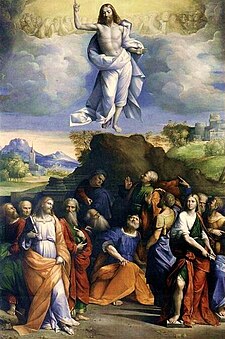 Ascension Day – May 13th
Ascension Day – May 13th
Today, May 13th, is the day we celebrate Ascension Day.
Ascension Day celebrates Jesus ascension to heaven after he was resurrected on Easter Day. Ascension Day is the 40th day after Easter Sunday and always falls on a Thursday (hence its other name Holy Thursday).
Ascension, the name usually given to the departure of Jesus from earth as related in the Gospels according to Mark (16) and Luke (24) and in Acts 1.1-11. The annual commemoration of this is one of the principal feasts in most Christian churches.
“Forty Days after the Resurrection of Jesus Christ, the Acts of the Apostles records Jesus’ ascension into heaven. The ascension is an important Christian feast attesting and celebrating the reality of the God-Man Jesus Christ’s returning to the Father, to return again in the future parousia. The Ascension is the final component of the paschal mystery, which consists also of Jesus’ Passion, Crucifixion, Death, Burial, Descent Among the Dead, and Resurrection. Along with the resurrection, the ascension functioned as a proof of Jesus’ claim that he was the Messiah. The Ascension is also the event whereby humanity was taken into heaven. Finally, the ascension was also the “final blow” so-to-speak against Satan’s power, and thus the lion (Jesus) conquering the dragon (Satan) is a symbol of the ascension. Early Christian art and iconography portrayed the ascension frequently, showing its importance to the early Church.” (
“The Christian doctrine of the Ascension holds that Jesus ascended to heaven in the presence of his Eleven Apostles following hisresurrection, and that in heaven he sits at the right hand of God the Father.
Jesus died circa 30. In the Epistle to the Romans (c. 56-57),[1] Saint Paul describes Christ as in heaven and in the abyss[Rom. 10:5-7] the earliest Christian reference to Jesus in heaven. The most influential account of the Ascension, and according to the two-source hypothesisthe earliest,[2] is in Acts of the Apostles[1:1-11] where Jesus is taken up bodily into heaven forty days after his resurrection as witnessed by his apostles, after giving the Great Commission with a prophecy to return. In the Gospel of Luke, the Ascension takes place on Easter Sunday evening.[3] The Gospel of John (c. 90-100)[4] refers to Jesus returning to the Father.[Jn. 20:17] In the First Epistle of Peter (c. 90-110),[4] Jesus has ascended to heaven and is at God’s right side.[1 Pet. 3:21-22] The Epistle to the Ephesians (c. 90-100)[4] refers to Jesus ascending higher than all the heavens.[Eph. 4:7-13] The First Epistle to Timothy (c. 90-140)[4] describes Jesus as taken up in glory.[1 Tim. 3:16]The traditional ending of Mark[16:19] includes a summary of Luke’s resurrection material and describes Jesus as being taken up into heaven and sitting at God’s right hand. The imagery of Jesus’ Ascension is related to the broader theme of his exaltation and heavenly welcome, derived from the Hebrew Bible.[5] The image of Jesus rising bodily into the heavens reflects the ancient view that heaven was above the earth.[6]
Belief in the Ascension of Jesus is found in the Nicene Creed, and is affirmed by Christian liturgy and, in the West, by the Apostles’ Creed. The Ascension implies Jesus’ humanity being taken into heaven.[5] Ascension Day, celebrated 40 days after Easter, is one of chief feasts of the Christian year.[5] The feast dates back at least to the later 300s, as is widely attested.[5]” (http://en.wikipedia.org/wiki/Ascension_of_Jesus)
“The Catholic Catechism summarizes three important theological aspects (with which most Christian churches agree) of the Ascension concisely:
Christ’s Ascension marks the definitive entrance of Jesus’ humanity into God’s heavenly domain, whence he will come again (cf. Acts 1:11); this humanity in the meantime hides him from the eyes of men (cf. Col 3:3).
Jesus Christ, the head of the Church, precedes us into the Father’s glorious kingdom so that we, the members of his Body, may live in the hope of one day being with him for ever.
Jesus Christ, having entered the sanctuary of heaven once and for all, intercedes constantly for us as the mediator who assures us of the permanent outpouring of the Holy Spirit (665-667).” (
Ten days after Ascension Day is Pentecost which marks the coming of the Holy Spirit to the disciples